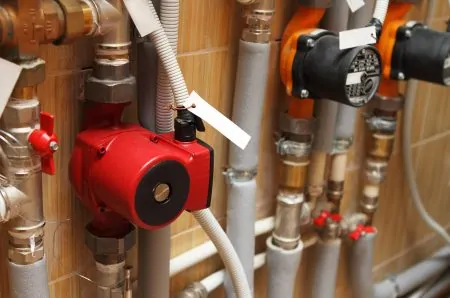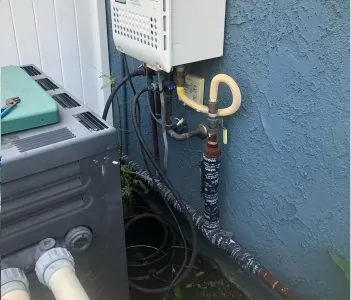Jumping into a hot shower on a cold winter morning is one of life’s pleasures. But what happens when the shower suddenly runs cold? You will need to know how to reset a water heater if you want to resolve the issue.
We explain what the electric water heater reset button does, how to reset it, and where you will find it on your water heater.
Key Takeaways
- Reset button is a safety feature: The reset button on a water heater is designed to cut power when there’s an issue, preventing damage or injury.
- Locate the reset button: Typically found near the thermostat on the main control panel, sometimes hidden behind a protective cover.
- Press and hold the button: Hold the reset button for 30 seconds before releasing. If it stays on, the heater is reset. If it trips again, call a professional.
- Check for other issues: If the reset button doesn’t work, there may be other problems like a faulty thermostat, burnt-out heating element, or loose connections.
How the Reset Button Works
As water fills your hot water tank, the lower and upper elements kick in and warm the water. If there is a power overload or one of the elements is not working, the reset button trips and lights up. In most cases, it could be a simple breaker problem, and depressing the switch resets the system.
However, if the button keeps tripping, it could be a symptom of more significant problems.
It’s there as a safety mechanism to cut the power to the water heater. The last thing you would want is an electrical fire if one of the elements or the thermostat burns out.
Where Is the Reset Button on a Water Heater?
The button is typically located near the thermostat on the main control panel. You may need to remove a small cover to access the switch. You might have an additional thermostat reset button nearby.
To reactivate the water heater, press the button, and the system should be operational.
How to Reset a Water Heater
Knowing where the reset switch is located is one thing, but how do you reset a water heater? We show you how in easy-to-follow steps.
What You’ll Need
- Screwdriver.
- Gloves.
- Flashlight.
1. Check the Breaker Board
You will find your breaker board in the garage, basement, or storage closet. Check to see if the switch has tripped. If it’s in the “off” position, switch it back on and see if the heater works.
If the reset switch triggers but the breaker is still on, other factors might be at play.
2. Locate the Reset Switch
Look for the thermostat panel, and you should see the reset switch. Some models like Honeywell and Rheem may have a protective cover concealing the button. Use the screwdriver to remove the screws on the protection panel (and the insulation) to locate the switch inside.
Light can be limited if your water heater is in the basement or crawl space. Use a flashlight to help you locate the switch.
Safety Note
Don safety gloves when handling fiberglass insulation because it irritates your skin.
3. Push the Button
Press the switch and hold it for 30 seconds before releasing. If it stays on, your heater is reset. If it trips straight away, you may have more serious problems and need to call a professional.
While the panel is off, check for a second thermostat and a second reset button. Press it in if it has tripped as well.
Take Note
You will have to wait for a couple of hours while your water heater returns to temperature.
4. Replace the Panel
Place the insulation back into the cavity and replace the protective panel. Screw it back in place, and you’re all set.
How Long for Water to Heat After Reset?
The time your hot water tank takes to reach the correct temperature varies between models and sizes. It will take longer for a 60-liter tank to heat than a 40-liter model. By contrast, tankless RV water heaters deliver almost instant hot water.
On average, it should only take a couple of hours for your water to heat after a restart but check with your manufacturer.
What Trips the Reset Button on a Water Heater?
There are several reasons why the reset button trips, but some are more common than others. Here’s a list of the usual suspects:
Faulty Thermostat
The thermostat controls the heating elements and tells them to shut off when the water reaches the correct temperature. If the thermostat is faulty, it can’t communicate properly, and the elements risk burning out.
As a fail-safe, the reset button triggers and shuts the system down so that the elements are protected, along with other components. Replacing a thermostat is relatively straightforward. You can access the screws via the panel behind the insulation.
Thermostats are also fairly inexpensive. This Reliance thermostat is a perfect choice and super affordable. However, you will spend considerably more if you have a gas water heater. This Rheem gas thermostat is a great product but several times the price of the Reliance model.
Burnt-Out Heating Element
If you have a burnt-out heating element, it could also mean your thermostat is faulty. The two are interconnected and communicate to ensure the water temperature is correct. If that connection is lost, the element will keep heating until it burns up.
Use a multimeter, like this AstroAI 2000, to check for an electrical current going to the element and thermostat. Once you’ve determined the issue, you can swap it for a new model. This Camco screw-in element is cheap and easy to buy online.
Faulty Reset Button
If your reset button is the problem, your water heater has no safety net should it overheat or develop other faults. Look at the breaker board to check if the reset switch is faulty. The switch may be faulty if the breaker is still on, but the system has tripped.
Faults may range from stuck switches that won’t push in to loose connections cutting power to the button. If the button doesn’t click when you press it, you may need to replace it.
The best way to deal with this issue is to call the pros. You can attempt to replace the switch yourself, and they are cheap to buy online. But only do this if you have some experience with water heaters.
This Bradford White switch is less than $20, and you can pick it up online or at hardware stores.
Loose Connection
Sometimes the problem is as simple as a loose wire. Check the connections on the thermostat, element, and reset switch before reaching for the phone. A multimeter is a great way to determine if the components have power.
Another way of checking for loose connections is to check the breaker board. If the breaker is on, it is likely a problem with a loose wire tripping the system. Tighten the connections and then push the reset button.
Take Note
Always turn off the power before tightening any loose wires or connections.
Corrosion of Internal Parts
Typically, the heating elements are the most likely to corrode, but in hard water areas, the thermostats and the inside of the water tank suffer too. Mineral deposits coat the components, baking on a hard shell.
The best way to avoid corrosion is to clean the water heater at least once a year, flushing out the accumulated limescale and debris.
When to Replace a Water Heater
The average water heater will last between eight and 12 years. That doesn’t mean you should swap it the minute it gets old, but it does lose efficiency with age.
Also, components like thermostats and heating elements have a finite life and start to fail. So, when you repair your water heater more frequently than before, it may be time to bite the bullet and get a new one.
FAQs
Keep it Safe
The reset button is there for safety reasons — to avoid boiling water or damage to the unit. Resetting is easy and can be done in a couple of minutes. However, if the button refuses to reset, call a professional as it could indicate a larger problem.















